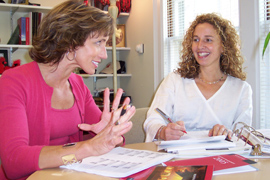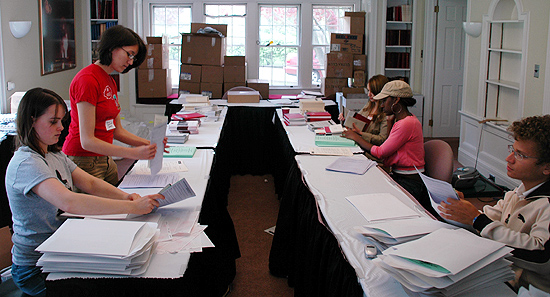Behind the Scenes: Reunion & Commencement Weekend Result of All Departments
 At top, hired students worked stuffed 3,000 packets and created nametags in preparation for Reunion & Commencement Weekend at University Relations. At top, hired students worked stuffed 3,000 packets and created nametags in preparation for Reunion & Commencement Weekend at University Relations.
At left, Gemma Ebstein, director of Alumni and Parent Relations and Deana Hutson, director of Events, look over Reunion & Commencement Weekend schedules prior to the four-day event. |
|
| Posted 05/23/05 | |
|
It all starts the day after. Deana Hutson, director of Events, began planning for the 2005 Reunion & Commencement Weekend the day after the 2004 Commencement Weekend ended. On the agenda: Hire 150 student workers. Print 20,000 brochures. Rent 10,000 chairs. Block 900 local hotel rooms. Contact 50 vendors. Plan events for 9,000 guests. There is so much going on behind the scenes of Reunion & Commencement Weekend, says Hutson, who has been critical to the success of six R&Cs so far. It starts with a small team of staff meeting and program planning and culminates with a team of 1,000 making it happen. We want alumni, parents and seniors to walk away with wonderful memories of the weekend. On May 16, just three days before the big weekend, Hutson and Gemma Ebstein, director of Alumni and Parent Relations, spend their day going through a pen-scribbled list and an 80-page flow document. The document details who is in charge of each event, the time of the event and a description. The duo coordinates more than 150 individual events including picnics, dinners, parties, academic department tours, senior projects, campus walking tours, 36 WESeminars, 15 class reunions, a parade, an annual meeting and assembly, a grandparents gathering, a childrens day camp, class photos and of course, the 173rd commencement ceremony. We just go with the flow, says Ebstein, who has co-coordinated 14 reunions and six reunion and commencement events. These lists may look crazy, but it explains everything we need to do to run the weekend. Ebstein says virtually all the universitys departments contribute to the weekend in one way or another. Physical Plant staff spends Saturday night setting up chairs for commencement. Campus Dining prepares more than 90 percent of all meals. The Office of University Communications writes, photographs and edits the brochures and award citations. The Wesleyan grounds crew grooms the campus lawns and flower beds. And all academic departments plan open houses for the weekend. Even students get involved. More than 500 students apply for R&C Weekend employment, but only 150 are hired. They often cover odd-hour shifts, some beginning at 6 a.m. and ending at 2 a.m. the next morning. Students want to be here working for commencement, Hutson says. They enjoy it. Its a lot of fun. And we want them here. Theyre representing Wesleyan, and theyre proud of their school. Alumni love talking to the students, and for the students, meeting Wesleyan alumni on this weekend puts it all into perspective for them. When planning more than 150 events throughout the weekend challenges are sure to arise. The staff, however, is accustomed to expect the unexpected. About 670 alumni registered for 2005 reunion, however, an additional 350 can show up depending on the weather. The coordinators keep their eye on the numbers, which can affect last-minute food orders, rental orders, tables and table cloths, napkins, tables, chairs, silverware, plates, glasses and even the number of flower and balloon arrangements. And in recent years, challenges have run the gamut: Brochures and nametags were delivered incorrectly printed. the University Relations staff stayed up throughout the night to get them finished days before the event. Were constantly problem solving, Ebstein says. Even with the best laid plans, things go awry. The key is to stay calm, be pleasant, assess options and take action. We strive to do everything possible to make this weekend a positive experience for alumni and parents. Some alumni may not return to campus for another five years, so this experience really matters. Members of University Relations and Physical Plant are assigned different tasks, but among the most important are to be the eyes and ears of the university. All problems and questions are communicated through cell phones and radios. Seventy-two of them to be exact. Crunch time for University Relations begins in March when brochures are mailed off, a Web site is developed and registration begins. In May, the staff begins working longer hours and weekends. During the R&C weekend, some of them sleep an average of two hours a night. The staff includes Makaela Steinberg, associate director of Alumni Relations; Linda Kavan, associate director of Events, Suzanne Kampen, administrative assistant with Alumni and Parent Relations; Gail Briggs, associate director of Alumni Education, Meg Zocco, director of Parent Programs and Camille Dolansky, assistant director of Parent Programs. Jean Shaw, now coordinator of University Lectures, was the overall coordinator from 2000-2003, helping to combine the once separate reunion and commencement celebrations into one event. The hectic schedule affects their personal life, and Hutson and Ebstein say it takes an understanding family to get through it. My husband knows Ill be coming home late every night, and my sons know I cant make it to their basketball and soccer games this time of year, Ebstein says. But when they come and see what the weekend is all about, then they get it. Hutson compares planning for R&C Weekend like a running up a hill. It can be agonizing trying to get up and over that hill, but once youre on top you’re so proud of what you’ve accomplished, you forget how hard it was to get there. After R&C Weekend, the University Relations staff sends evaluation assessments to alumni. Feedback lets Wesleyan know theyre efforts pay off in the end. Although we offer many ways for alumni to stay connected, reunion weekend is one of the more traditional programs and has a unique appeal, Ebstein says. Sometimes alumni won’t have much contact with Wesleyan for many years, then return for reunion and gradually become re-engaged. There’s really something special about the reunion experience; it has a lasting impact. And then on Monday, the planning starts for 2006. |
By the Numbers:
562 2 48 300 10,000 300 3,000 20,000 72 |
| By Olivia Drake, The Wesleyan Connection editor | |


 ]]>
]]>